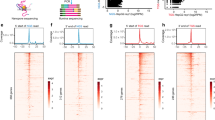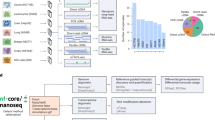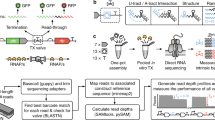Abstract
The majority of the mammalian genome is transcribed into RNAs, most of which are noncapped RNAs (napRNAs) that not only regulate diverse biological processes through their functions as noncoding RNAs but also serve as processing products to delineate specific RNA biogenesis pathways. However, due to their heterogeneous lengths, diverse terminal modifications and complex secondary structures, identifying these napRNAs poses substantial challenges. Recently, we developed a napRNA sequencing technique (NAP-seq) to identify full-length sequences of napRNAs with various terminal modifications at single-nucleotide resolution. Here we describe the experimental design principles and detailed step-by-step procedures for discovering napRNAs across multiple cell types. The procedure includes T4 polynucleotide kinase pretreatment to standardize RNA termini, enabling comprehensive capture of modified napRNAs; size-selection followed by depletion of known high-abundance RNAs via RNase H to enrich long and low-abundance RNAs; and use of custom-designed adapters with random barcodes, permitting identification of full-length napRNAs at single-nucleotide resolution while minimizing PCR biases and adapter ligation inefficiencies. The use of thermally stable reverse transcriptase enzymes and nested reverse transcriptase primers ensures full-length cDNA synthesis across structured or modified RNA regions while minimizing mispriming artifacts. Libraries are sequenced in parallel using Oxford Nanopore (long-read) and Illumina (short-read) platforms, synergizing advantages of third-generation and next-generation sequencing technologies. The entire experimental procedure, from library preparation to deep sequencing and computational analysis, can be completed within 8 d. The NAP-seq approach enables researchers to discover novel classes of noncoding RNAs with regulatory functions and to investigate RNA biogenesis in various tissues and cell lines.
Key points
-
By leveraging a combination of multienzymatic treatments and various advanced experimental strategies, NAP-seq achieves comprehensive profiling of full-length noncapped RNAs with various terminal modifications and complex secondary structures at single-nucleotide resolution.
-
NAP-seq enables the discovery of previously unidentified long noncapped RNAs, revealing diverse classes of novel structured noncoding RNAs with regulatory functions by combining the strengths of both short- and long-read sequencing platforms.
This is a preview of subscription content, access via your institution
Access options
Access Nature and 54 other Nature Portfolio journals
Get Nature+, our best-value online-access subscription
$32.99 / 30 days
cancel any time
Subscribe to this journal
Receive 12 print issues and online access
$259.00 per year
only $21.58 per issue
Buy this article
- Purchase on SpringerLink
- Instant access to full article PDF
Prices may be subject to local taxes which are calculated during checkout




Similar content being viewed by others
Code availability
All software used in this Protocol is described in detail in the ‘Equipment’ section and is available via Github: napSeeker at https://github.com/junhong-huang/napSeeker, cutNapAdapter at https://github.com/junhong-huang/cutNapAdapter and the Perl scripts at https://github.com/junhong-huang/NAP-seq-Perl-scripts.
References
Djebali, S. et al. Landscape of transcription in human cells. Nature 489, 101–108 (2012).
Ramanathan, A., Robb, G. B. & Chan, S. H. mRNA capping: biological functions and applications. Nucleic Acids Res. 44, 7511–7526 (2016).
Proudfoot, N. J., Furger, A. & Dye, M. J. Integrating mRNA processing with transcription. Cell 108, 501–512 (2002).
White, R. J. RNA polymerases I and III, growth control and cancer. Nat. Rev. Mol. Cell Biol. 6, 69–78 (2005).
Sharifi, S. & Bierhoff, H. Regulation of RNA polymerase I transcription in development, disease, and aging. Annu. Rev. Biochem. 87, 51–73 (2018).
Li, B. et al. RIP-PEN-seq identifies a class of kink-turn RNAs as splicing regulators. Nat. Biotechnol. 42, 119–131 (2024).
Malka, Y. et al. Alternative cleavage and polyadenylation generates downstream uncapped RNA isoforms with translation potential. Mol. Cell 82, 3840–3855.e3848 (2022).
El-Brolosy, M. A. et al. Genetic compensation triggered by mutant mRNA degradation. Nature 568, 193–197 (2019).
Donayo, A. O. et al. Oncogenic biogenesis of pri-miR-17~92 reveals hierarchy and competition among polycistronic microRNAs. Mol. Cell 75, 340–356 e310 (2019).
Hafner, M. et al. Barcoded cDNA library preparation for small RNA profiling by next-generation sequencing. Methods 58, 164–170 (2012).
Eminaga, S., Christodoulou, D. C., Vigneault, F., Church, G. M. & Seidman, J. G. Quantification of microRNA expression with next-generation sequencing. Curr. Protoc. Mol. Biol. 17 (2013).
Ruby, J. G. et al. Large-scale sequencing reveals 21U-RNAs and additional MicroRNAs and endogenous siRNAs in C. elegans. Cell 127, 1193–1207 (2006).
Shi, J. et al. PANDORA-seq expands the repertoire of regulatory small RNAs by overcoming RNA modifications. Nat. Cell Biol. 23, 424–436 (2021).
Mortazavi, A., Williams, B. A., McCue, K., Schaeffer, L. & Wold, B. Mapping and quantifying mammalian transcriptomes by RNA-Seq. Nat. Methods 5, 621–628 (2008).
Nagalakshmi, U. et al. The transcriptional landscape of the yeast genome defined by RNA sequencing. Science 320, 1344–1349 (2008).
Mohr, S. et al. Thermostable group II intron reverse transcriptase fusion proteins and their use in cDNA synthesis and next-generation RNA sequencing. RNA 19, 958–970 (2013).
Nottingham, R. M. et al. RNA-seq of human reference RNA samples using a thermostable group II intron reverse transcriptase. RNA 22, 597–613 (2016).
Qin, Y. et al. High-throughput sequencing of human plasma RNA by using thermostable group II intron reverse transcriptases. RNA 22, 111–128 (2016).
Garalde, D. R. et al. Highly parallel direct RNA sequencing on an array of nanopores. Nat. Methods 15, 201–206 (2018).
Workman, R. E. et al. Nanopore native RNA sequencing of a human poly(A) transcriptome. Nat. Methods 16, 1297–1305 (2019).
Ibrahim, F., Oppelt, J., Maragkakis, M. & Mourelatos, Z. TERA-seq: true end-to-end sequencing of native RNA molecules for transcriptome characterization. Nucleic Acids Res. 49, e115 (2021).
Liu, S. et al. NAP-seq reveals multiple classes of structured noncoding RNAs with regulatory functions. Nat. Commun. https://doi.org/10.1038/s41467-024-46596-y (2024).
The ENCODE Project Consortium. An integrated encyclopedia of DNA elements in the human genome. Nature https://doi.org/10.1038/nature11247 (2012).
Siegfried, N. A., Busan, S., Rice, G. M., Nelson, J. A. E. & Weeks, K. M. RNA motif discovery by SHAPE and mutational profiling (SHAPE-MaP). Nat. Methods 11, 959–965 (2014).
Spitale, R. C. et al. Structural imprints in vivo decode RNA regulatory mechanisms. Nature 519, 486–490 (2015).
Luo, Q.-J. et al. RNA structure probing reveals the structural basis of Dicer binding and cleavage. Nat. Commun. 12, 3397 (2021).
Lucks, J. B. et al. Multiplexed RNA structure characterization with selective 2′-hydroxyl acylation analyzed by primer extension sequencing (SHAPE-Seq). Proc. Natl Acad. Sci. USA 108, 11063–11068 (2011).
Smola, M. J., Rice, G. M., Busan, S., Siegfried, N. A. & Weeks, K. M. Selective 2′-hydroxyl acylation analyzed by primer extension and mutational profiling (SHAPE-MaP) for direct, versatile and accurate RNA structure analysis. Nat. Protoc. 10, 1643–1669 (2015).
Jain, M. et al. Nanopore sequencing and assembly of a human genome with ultra-long reads. Nat. Biotechnol. 36, 338–345 (2018).
Phelps, W. A., Carlson, A. E. & Lee, M. T. Optimized design of antisense oligomers for targeted rRNA depletion. Nucleic Acids Res. 49, e5–e5 (2021).
Martin, M. Cutadapt removes adapter sequences from high-throughput sequencing reads. J. EMB 24, 1138–1143 (2011).
Dobin, A. et al. STAR: ultrafast universal RNA-seq aligner. Bioinformatics 29, 15–21 (2013).
Li, H. Minimap2: pairwise alignment for nucleotide sequences. Bioinformatics 34, 3094–3100 (2018).
Kawaji, H., Kasukawa, T., Forrest, A., Carninci, P. & Hayashizaki, Y. The FANTOM5 collection, a data series underpinning mammalian transcriptome atlases in diverse cell types. Sci. Data 4, 170113 (2017).
Noguchi, S. et al. FANTOM5 CAGE profiles of human and mouse samples. Sci. Data 4, 170112 (2017).
Li, H. et al. The Sequence Alignment/Map format and SAMtools. Bioinformatics 25, 2078–2079 (2009).
Quinlan, A. R. & Hall, I. M. BEDTools: a flexible suite of utilities for comparing genomic features. Bioinformatics 26, 841–842 (2010).
Thorvaldsdottir, H., Robinson, J. T. & Mesirov, J. P. Integrative Genomics Viewer (IGV): high-performance genomics data visualization and exploration. Brief. Bioinform. 14, 178–192 (2013).
Acknowledgements
This work was supported by the National Key R&D Program of China (grant nos. 2024YFC3405901 to J.Y., 2022YFA1303300 to J.Y. and 2024YFC3407001 to B.L.), the National Natural Science Foundation of China (grant nos. 32225011 to J.Y., 32430019 to J.Y., 32470598 to S.L. and 32370588 to B.L.), Guangdong S&T Program (grant no. 2024B1111130003 to J.Y.), GuangDong Basic and Applied Basic Research Foundation (grant nos. 2025A1515010287 to S.L. and 2025B1515020051 to B.L.) and Funding by Science and Technology Projects in Guangzhou (grant nos. 2025A04J3498 to S.L. and 2025A04J3301 to B.L.).
Author information
Authors and Affiliations
Contributions
S.L., B.L., Q.L. and J.Y. conceived and designed the entire project. S.L. designed, implemented and optimized the NAP-seq experimental protocol. J.H. and J.Y. designed the data-processing pipeline and tested the computational pipeline. S.L. and J.Y. prepared the manuscript.
Corresponding authors
Ethics declarations
Competing interests
The authors declare no competing interests.
Peer review
Peer review information
Nature Protocols thanks Piero Carninci, Monika Kwiatkowska, Junchao Shi, Barbara Uszczynska-Ratajczak and the other, anonymous reviewer(s) for their contribution to the peer review of this work.
Additional information
Publisher’s note Springer Nature remains neutral with regard to jurisdictional claims in published maps and institutional affiliations.
Key reference
Liu, S. et al. Nat. Commun. 15, 2425 (2024): https://doi.org/10.1038/s41467-024-46596-y
Supplementary information
Supplementary Table 1
rRNA-targeting DNA oligonucleotides for NAP-seq.
Rights and permissions
Springer Nature or its licensor (e.g. a society or other partner) holds exclusive rights to this article under a publishing agreement with the author(s) or other rightsholder(s); author self-archiving of the accepted manuscript version of this article is solely governed by the terms of such publishing agreement and applicable law.
About this article
Cite this article
Liu, S., Huang, J., Qu, L. et al. NAP-seq for full-length noncapped RNA sequencing. Nat Protoc (2025). https://doi.org/10.1038/s41596-025-01261-6
Received:
Accepted:
Published:
DOI: https://doi.org/10.1038/s41596-025-01261-6



